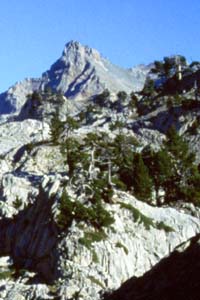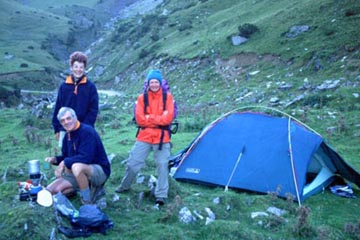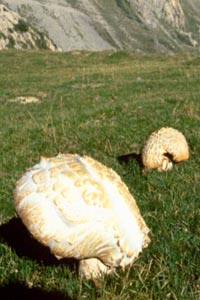In detail ...
Karen_comments
We awoke to a cool morning and an easy pack from our hut based stay. Karen seemed to be symptom free after yesterday's malady, and we departed promptly in order to recover the 350m altitude back to the frontier ridge. Just 5min out, we bumped into the Swiss for the last time during our trek; Madame had limped and hobbled courageously indeed. We exchanged news, photos, packet soups, and left with final warnings about the
karstic country. 'You will be as miniature ...' Monsieur said. In the whole trek, they were the only other walkers attempting a substantial section of the HRP and we met no-one else attempting to do the traverse in one go.
The way led by a stream and boggy terrain, where we were fortunate to find a fire salamander doing slow-motion on the way to a good day's sleep. The ground levelled out to gain the col Uthurourdinetako Portilloua (1664m) where
comme d'habitude we had our breakfast after meeting the sun at the top of the day's first climb. The way ahead comprised a series of a scenic balcony traverses with heather, juniper and struggling pine trees framing the views, firstly on the south side of Chardekagagna. We gratefully collected more large mushrooms on the way to Col de Bimbaleta (1677m),
Voici!
where we found a black-bére'd shepherd observing his flock pensively, hands and chin propped on his tall staff.
The valley view to the south was stupendous; great calcerous cliffs had shed immense boulders to jumble chaotically in the green pastures below, and beyond, the darker green forests framed all. It was even more impressive from the exposed traverse south of Pic Bimbaleta, where I was happy to note Karen taking things in her stride; she was still learning to use the trekking poles to best advantage.
Down at Port d'Ourdayte (1476m), I checked the altimeter to ensure we held the slopes of Lakhoura until appropriate; the wrong path would bring us to an unwanted tarmac ascent. The correct way was located, leading us past gushing springs which had cut deep ravines into the hillside, then we mingled with scattered pines before emerging just above the unlikely looking Ref Belagua, with its steep copper-clad roofs. Despite the semblance of total efficiency completed by helipad, the staff within were most un-helpful when we asked for food. We were about 1hr early for dinner and no food would be available while they themselves ate. Our mouths (and eyes!) watered a little; it would be a gross extravagence to wait for a whole hour.
Karen_comments
Of value was the time spent perusing a detailed map posted on the wall, gaining knowledge of the complex topography, though our note of the water-courses was not so helpful; the
karstic country swallows water in all but the wettest season. It would have been better had we searched out a local to interrogate, but we set forth cheerfully on a good trail, still with no real notion of the difficulty ahead. The obvious trail lasted about 2km and when it did look a bit vague we searched around; 'A track which begins must continue ...' Our general direction was correct, but as the terrain was tree covered it became impossible to tell the most efficient route to proceed.

Likely, there was no efficient route for we had entered a maze; 1001 lost canyons, a mixture of bowls, ravines and cliffs having no contiguous line of access. An un-earthly silence pervaded this wilderness, and round us nature bloomed, undisturbed by trampling cattle or curious tourist. Trees, flowers, fungi, and creatures which we heard rather than saw; it really was an enchanted fairy-land which we would have liked to explore better, but for the need to extricate ourselves! I 'set to', climbing the nearest cliff or tree, shouting contact calls to Karen but guiding features were not obvious for a long time as we followed the compass.
Hope re-kindled as we entered a broad gully, but then dashed as it kinked off course; there was not going to be any easy solution. Up, down, and round; scramble the rocks, balance along a tree-trunk, descend, check the compass and re-ascend. Rough limestone tenderised the fingers and seedling beech trees whipped back into our faces; we were weary but at least it was cool in the shade. Eventually, my reconnaissance noted a distinct cliff line bordering a larger valley we must reach, and hope was established, which did not however make the intervening terrain any easier. We remained energetic but out of water; the prunes we snacked on only aggravated thirst.
At last we reached a definite valley line with rough meadows. Following what should have been a stream, we were amazed to suddenly encounter aged yellow
balisage. 'At least now' we thought, 'things will be easier'; easier but still not easy. We had still to dodge around the beech seedlings, scramble out of gullies and search hard for the markers, but we had some re-assurance that this course was leading somewhere, verified still by the compass.
We shortly identified Point 1683m , with its stark, still scenery;
Voici!
the beeches had thinned out to leave only pines set against the shattered pallid escarpments. The ever-changing subterranean network of water-courses had spelled fatal consequences for certain trees with no respect for size and age. Still they stood, with brittle branches cracked and ashen beneath the scorching sun; bark and lustrous needles had been traded for dull wizened lichens that hung in tattered beards. Which reminded us that our problem of thirst remained, now compounded by the thinning trees; no shade. We set out once more to navigate an easing passage, which yielded a reassuring distant view of Pic d'Anie, and the Col d'Anaye (2010m) which we must gain next to it. After too many false horizons, we finally arrived there at 7pm,
Voici!
with tacky saliva and itching eyes; we had not drunk for 6hrs in the heat.
The Bearded Vulture
French: 'Gypaete Barbu'. This monarch of the Pyrenees (aka Lammergeier), only ever feeds on carrion, but believing otherwise, the locals once persecuted it to extinction. In fact, this vulture has the mildest manners, only attending a kill after the Griffons have finished, for it subsists largely on marrow extracted from larger bones; these it carries to a height before releasing them to shatter on rocks below. It is distinguished from the Griffons by its large size, orange-brown head/neck feathers and wedge shaped tail; it is solitary in nature.
The occasion was marked by the first sighting of a Lammergeier, sailing straight and solemn overhead on its way towards the impending cliffs which now surrounded us, a cathedral of sorts. Perhaps it had just quit waiting for us to drop, for it would know that just below, clean water flowed from an original spring; that would be near the wisp of smoke which curled upwards from someone's camp-fire. Once in descent the terrain simplified immediately, and we were pleasantly distracted by tiny thistles shaded a delicate pastel azure; the Chardon Bleu was common here, brightening the otherwise arid screes.
Then we had it; the purest streams of limpid life-giving water imaginable, making the sweetest music as it coursed over rock and rill, what a relief! Here too were ample opportunities to pitch the tent on verdant flats and rest at the end of a very trying day.
Karen_comments
We relaxed slowly and camp duties were completed, which soon yielded our dinner; pasta with sardines and the big mushrooms. There we lazed in awe, as the remains of the day painted the great eastern cliffs with a warm rosé alpenglow. They were in turn blanched by the linen-pale moonlight which, in concord with the cool air at this altitude soothed the last of the day's fervour in mind and body.



